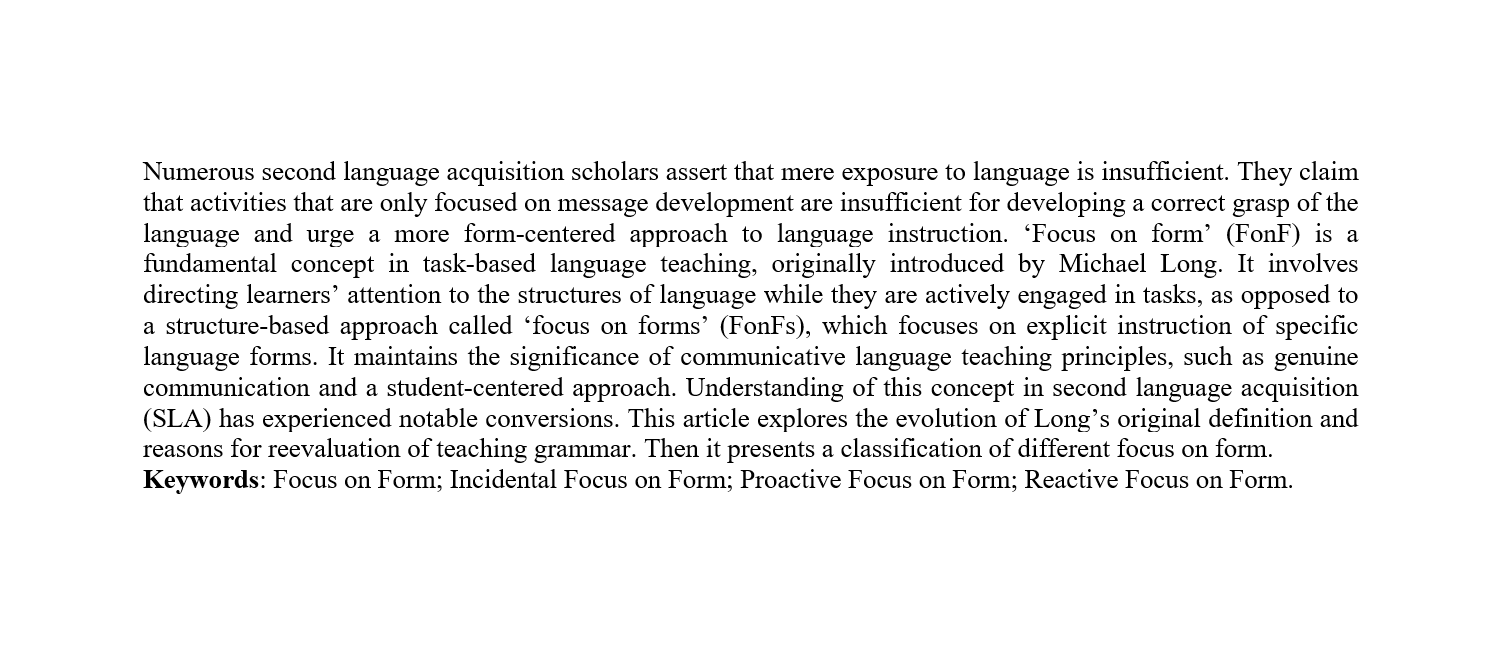Focus on Form Approach in English Foreign Language Teaching
DOI:
https://doi.org/10.21271/zjhs.28.1.7Keywords:
Focus on Form, Incidental Focus on Form, Reactive Focus on Form, Proactive Focus on FormAbstract
Numerous second language acquisition scholars assert that mere exposure to language is insufficient. They claim that activities that are only focused on message development are insufficient for developing a correct grasp of the language and urge a more form-centered approach to language instruction. ‘Focus on form’ (FonF) is a fundamental concept in task-based language teaching, originally introduced by Michael Long. It involves directing learners’ attention to the structures of language while they are actively engaged in tasks, as opposed to a structure-based approach called ‘focus on forms’ (FonFs), which focuses on explicit instruction of specific language forms. It maintains the significance of communicative language teaching principles, such as genuine communication and a student-centered approach. Understanding of this concept in second language acquisition (SLA) has experienced notable conversions. This article explores the evolution of Long’s original definition and reasons for reevaluation of teaching grammar. Then it presents a classification of different focus on form.
References
Cadierno, T. (1995). Formal instruction from a processing perspective: An investigation into the Spanish past tense. Modern Language Journal, 79(2), 179. https://doi.org/10.2307/329618
Dekeyser, R. (2001). Cognition and second language instruction (P. Robinson, Ed.). Cambridge University Press.
Doughty, C. (2001). Cognition and second language instruction (P. Robinson, Ed.). Cambridge University Press.
Doughty, C., & Long, M. (2003). The handbook of second language acquisition. Blackwell Publishing.
Doughty, C., & Williams, J. (1998). Focus on form in classroom second language acquisition. Cambridge University Press.
Ellis, R. (2001). Introduction: Investigating form-focused instruction. Language Learning, 51, 1–46. https://doi.org/10.1111/j.1467-1770.2001.tb00013.x
Ellis, R. (2002). Does form-focused instruction affect the acquisition of implicit knowledge? A review of the research. Studies in Second Language Acquisition, 24, 223–236.
Ellis, R. (2003). Task-based language learning and teaching. Oxford University Press.
Ellis, R. (2016). Focus on form: A critical review. Language Teaching Research, 20(3), 405–428. https://doi.org/10.1177/1362168816628627
Ellis, R., Basturkmen, H., & Loewen, S. (2002). Doing focus-on-form. System, 30(4), 419–432. https://doi.org/10.1016/s0346-251x(02)00047-7
Krashen, S. D. (1993). Comments on Stephen D. Krashen’s “teaching issues: Formal grammar instruction”. The effect of formal grammar teaching: Still peripheral. TESOL Quarterly, 27(4), 722. https://doi.org/10.2307/3587405
Krashen, S. D. (1999). Seeking a role for grammar: A review of some recent studies. Foreign Language Annals, 32, 245–257.
Larsen-Freeman, D. (2011). Techniques and principles in language teaching (3rd ed.). Oxford University Press.
Long, M. H. (1983) “Does Second Language Instruction Make a Difference?” A Review of Research. TESOL Quarterly, 17, pp. 359–382.
Long, M. H. (1991). Focus on form: A design feature in language teaching. In K. D. Bot, R. B. Ginsberg, & C. Kramsch (Eds.), Foreign language research in cross-cultural perspective (pp. 39–52).
Norris, J. M. and Ortega, L. (2000) “Effectiveness of L2 instruction: A research synthesis and quantitative meta-analysis,” Language learning, 50(3), pp. 417–528. doi: 10.1111/0023-8333.00136.
Pienemman, M. (1998). Language processing and second language development: Processability theory. John Matters.
Poole, A. (2005). Focus on form instruction: Foundation, application, and criticism. The Reading Matrix, 5, 47–56.
Prabhu, N. S. (1987). Second Language Pedagogy. Oxford University Press.
Richards, J. C., & Rodgers, T. S. (2017). Approaches and methods in language teaching create eBook. Cambridge University Press.
Robinson, P. (2001). Task complexity, task difficulty, and task production second language: Exploring interactions in a componential framework. Applied Linguistics, 22, 27–57.
Schmidt, R. (2001). Attention. In P. Robinson (Ed.), Cognition and second language instruction (pp. 3–32). Cambridge University Press.
Seyyedi, K., Ismail, S. A. M. M. (2014). The Effect of Task Structure on Second Language Learner’s Narrative Writing Performance. Journal of Foreign Languages, 2(1), 41–53.
Seyyedi, K., Ismail, S. A. M. M., Orang, M., & Sharafi Nejad, M. (2013). The effect of pre-task planning time on L2 learners’ narrative writing performance. English Language Teaching, 6(12). https://doi.org/10.5539/elt.v6n12p1
Seyyedi, K., & Ismail, S. A. M. M. (2012). Task-based Instruction. International Journal of Linguistics, 4(3). https://doi.org/10.5296/ijl.v4i3.2203
Skehan, P. (2018). A framework for the implementation of task-based instruction 1. In Second Language Task-Based Performance (pp. 13–34). Routledge.
Spada, N. (1997). Form-focussed instruction and second language acquisition: A review of classroom and laboratory research. Language Teaching, 30(2), 73–87. https://doi.org/10.1017/s0261444800012799
Swain, M., & Lapkin, S. (1998). Interaction and second language learning: Two adolescent French immersion students working together. The Modern Language, 320–337.
Truscott, J. (1998). Noticing in second language acquisition: A critical review. Second Language Research, 14, 103–135.
Wilkins, D. A. (1976). Notional Syllabuses: A Taxonomy and Its Relevance to Foreign Language Curriculum Development. Oxford: Oxford University Press.

Downloads
Published
Issue
Section
License
Copyright (c) 2024 Keivan Seyyedi, Sirvan Aminzadeh, Jamal Ali Omar

This work is licensed under a Creative Commons Attribution 4.0 International License.









